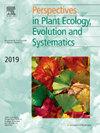欧亚温带 Lemna minor、L. turionifera 和 L. × japonica(Lemnaceae)随气候变化的分布及其基因组大小的高变异性
IF 3.5
3区 环境科学与生态学
Q1 ECOLOGY
Perspectives in Plant Ecology Evolution and Systematics
Pub Date : 2024-11-01
DOI:10.1016/j.ppees.2024.125831
引用次数: 0
摘要
尽管浮萍生物学研究方兴未艾,但对其多样性的了解仍在进行中。我们研究了来自东欧和北亚的 174 个可靠鉴定(TUBB1 内含子长度多态性)的 Lemna minor 复合物样本(41 个 L. minor 所在地、58 个 L. turionifera 所在地和 75 个它们的杂交种 L. × japonica 所在地),并描述了它们的清晰分布模式。这主要是由气候偏好(即在不利条件下的生存能力)决定的。也就是说,L. minor 和 L. turionifera 在低地的分布范围被乌拉尔山脉分隔开来,种群分别位于山脉以西和以东,与气候大陆性的东移相吻合。然而,历史因素(即物种的欧洲起源)而非生态因素应能解释为什么在气候相当温和的俄罗斯远东地区南部没有 L. minor。杂交种对大陆性气候的耐受能力处于中间水平,并与其亲本之一共生。在南部山区(高加索和天山),这三个类群因地形决定的当地气候条件而分开。我们发现,每个类群的基因组大小都有很大的连续变异性(L. minor 和 L. turionifera 为 2 倍;L. × japonica 为 3 倍),这不是环境因素所能解释的。我们提出了一种利用形态学在温带欧亚大陆区分这三个类群的方法。我们尚未记录 L. aequinoctialis、L. minuta 和 L. turionifera 在东欧的入侵传播。本文章由计算机程序翻译,如有差异,请以英文原文为准。
Climate-dependent distribution of Lemna minor, L. turionifera and L. × japonica (Lemnaceae) in temperate Eurasia and high variability of their genome size
In spite of a burst of duckweed biology studies, understanding their diversity is still in progress. We examined 174 reliably-identified (intron length polymorphism in TUBB1) samples of the Lemna minor complex from East Europe and North Asia (41 localities of L. minor, 58 localities of L. turionifera, and 75 localities of their hybrid, L. × japonica) and described clear patterns of their distribution. It is mainly determined by climatic preferences (i.e., the ability to survive unfavorable conditions). Namely, the ranges of L. minor and L. turionifera in the lowlands are separated by the Urals, with populations located west and east of these mountains respectively and coinciding with an eastward increase of climate continentality. However, historical (i.e. European origin of the species) and not ecological factors should explain the absence of L. minor in rather mild climate of the southern Russian Far East. The hybrid has an intermediate ability to tolerate continental climate, and co-occurs with one of its parents. In southern mountains (the Caucasus and Tian-Shan) the three taxa are separated by local climate conditions, determined by the terrain. We revealed high continuous variability of genome sizes within each taxon (two-fold in L. minor and L. turionifera; three-fold in L. × japonica), which is not explained by environmental factors. We propose an approach for distinguishing these three taxa in temperate Eurasia using morphology. We have not documented the invasive spread of L. aequinoctialis, L. minuta and L. turionifera in East Europe.
求助全文
通过发布文献求助,成功后即可免费获取论文全文。
去求助
来源期刊
CiteScore
6.50
自引率
0.00%
发文量
28
审稿时长
67 days
期刊介绍:
Perspectives in Plant Ecology, Evolution and Systematics (PPEES) publishes outstanding and thought-provoking articles of general interest to an international readership in the fields of plant ecology, evolution and systematics. Of particular interest are longer, in-depth articles that provide a broad understanding of key topics in the field. There are six issues per year.
The following types of article will be considered:
Full length reviews
Essay reviews
Longer research articles
Meta-analyses
Foundational methodological or empirical papers from large consortia or long-term ecological research sites (LTER).

 求助内容:
求助内容: 应助结果提醒方式:
应助结果提醒方式:


